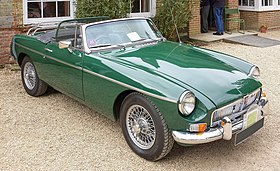MG RV8
| MG MGB | |
|---|---|

1969 MGB roadster
|
|
| Overview | |
| Manufacturer | BMC, later British Leyland |
| Production | 1962–80 |
| Assembly |
Abingdon, England Enfield, Australia Zetland, Australia |
| Body and chassis | |
| Class | Sports car |
| Layout | FR layout |
| Chronology | |
| Predecessor | MGA |
| Successor | MG F |
| MGB roadster | |
|---|---|
 |
|
| Overview | |
| Production | 1962–80 |
| Body and chassis | |
| Body style | 2-door roadster |
| Powertrain | |
| Engine | 1,798 cc (1.8 l) B-Series I4 |
| Dimensions | |
| Wheelbase | 2,312 mm (91.0 in) |
| Length | 3,886 mm (153.0 in) 4,019 mm (158.2 in) rubber bumper version |
| Width | 1,524 mm (60.0 in) |
| Height | 1,219 mm (48.0 in) 1,295 mm (51.0 in) rubber bumper version |
| MGB GT | |
|---|---|
 |
|
| Overview | |
| Production | 1965–80 |
| Body and chassis | |
| Body style | 2-door hatchback coupé |
| Powertrain | |
| Engine | 1,798 cc (1.8 l) I4 |
| Dimensions | |
| Wheelbase | 2,312 mm (91.0 in) |
| Length | 3,886 mm (153.0 in) 4,019 mm (158.2 in) rubber bumper version |
| Width | 1,524 mm (60.0 in) |
| Height | 1,238 mm (48.7 in) 1,295 mm (51.0 in) rubber bumper version |
| MGC & MGC GT | |
|---|---|
 |
|
| Overview | |
| Production | 1967–69 |
| Body and chassis | |
| Body style | 2-door roadster 2-door coupe |
| Powertrain | |
| Engine | 2,912 cc (2.9 l) C-Series I6 |
| MGB GT V8 | |
|---|---|

MGB GT V8
|
|
| Overview | |
| Production | 1973–1976 |
| Body and chassis | |
| Body style | 2-door coupe |
| Powertrain | |
| Engine | 3,528 cc (3.5 l) Rover V8 |
| MG RV8 | |
|---|---|
 |
|
| Overview | |
| Production | 1993–95 |
| Body and chassis | |
| Body style | 2-seat sports/racer |
| Powertrain | |
| Engine | 3,946 cc (3.9 l) Rover V8 |
| MG LE50 | |
|---|---|
| Overview | |
| Production | 2011- |
| Body and chassis | |
| Body style | 2-seat sports/racer |
| Powertrain | |
| Engine | 2,488 cc (2.5 l) Ford I4 |
The MGB is a two-door sports car manufactured and marketed by the British Motor Corporation (BMC), later British Leyland, as a four-cylinder, soft-top roadster from 1962 until 1980. Its details were first published on 19 September 1962. Variants include the MGB GT three-door 2+2 coupé (1965–1980), the six-cylinder roadster and coupé MGC (1967–1969), and the eight-cylinder 2+2 coupé, the MGB GT V8 (1973–1976).
Replacing the MGA in 1962, production of the MGB and its variants continued until 1980. Sales for the MGB, MGC and MGB GT V8 combined totaled 523,836 cars. The MGB bodyshell was reprised in modified form with a limited run of 2,000 MG RV8 roadsters (1993–1995).
In structure the MGB was an innovative, modern design in 1962, utilizing a monocoque structure instead of the traditional body-on-frame construction used on both the MGA and MG T-types and the MGB's rival, the Triumph TR series. However components such as brakes and suspension were developments of the earlier 1955 MGA with the B-Series engine having its origins in 1947. The lightweight design reduced manufacturing costs while adding to overall vehicle strength. Wind-up windows were standard, and a comfortable driver's compartment offered plenty of legroom. A parcel shelf was fitted behind the seats.
The MGB achieved a 0–60 mph (96 km/h) time of just over 11 seconds. The three-bearing 1,798 cc B-Series engine produced 95 hp (71 kW) at 5,400 rpm — upgraded in October 1964 to a five-bearing crankshaft. The majority of MGBs were exported to the US. In 1975 US-market MGB engines were de-tuned to meet emission standards, ride height was increased by an inch (25 mm), and distinctive rubber bumpers were fitted to meet bumper standards.
The MGB was one of the first cars to feature controlled crumple zones designed to protect the driver and passenger in a 30 mph (48 km/h) impact with an immovable barrier (200 ton). Despite this, the British AA motoring association has described the car, like many other classic models, as much less safe than modern cars. The issue received public attention following a 2013 case in which a driver in a hired 1963 MGB was killed in a collision with a taxi.
...
Wikipedia
